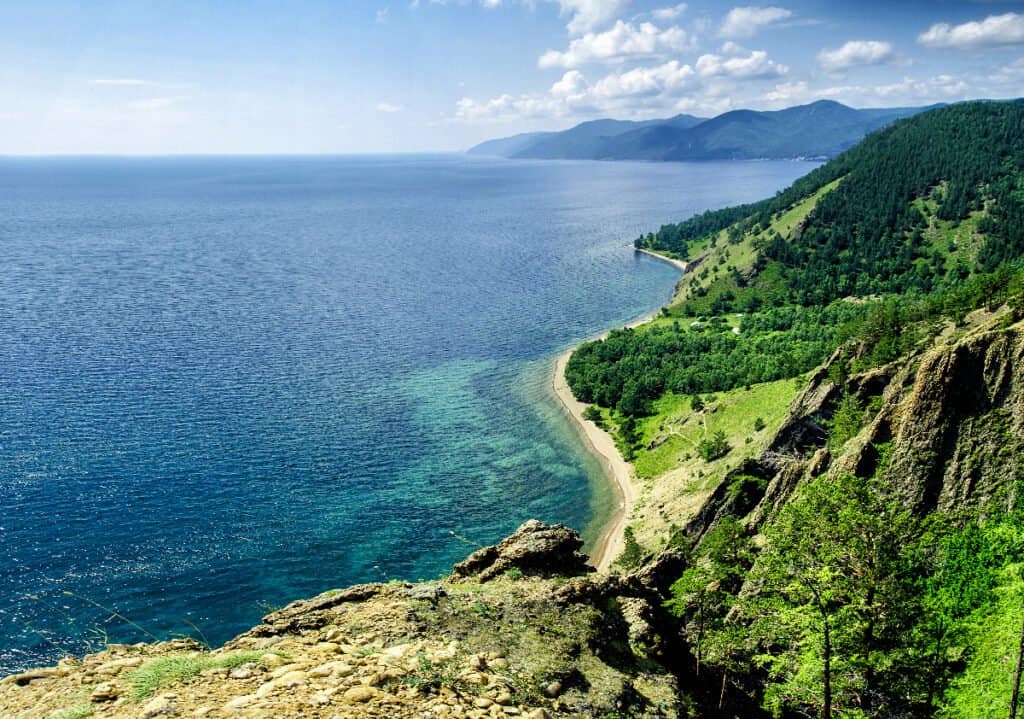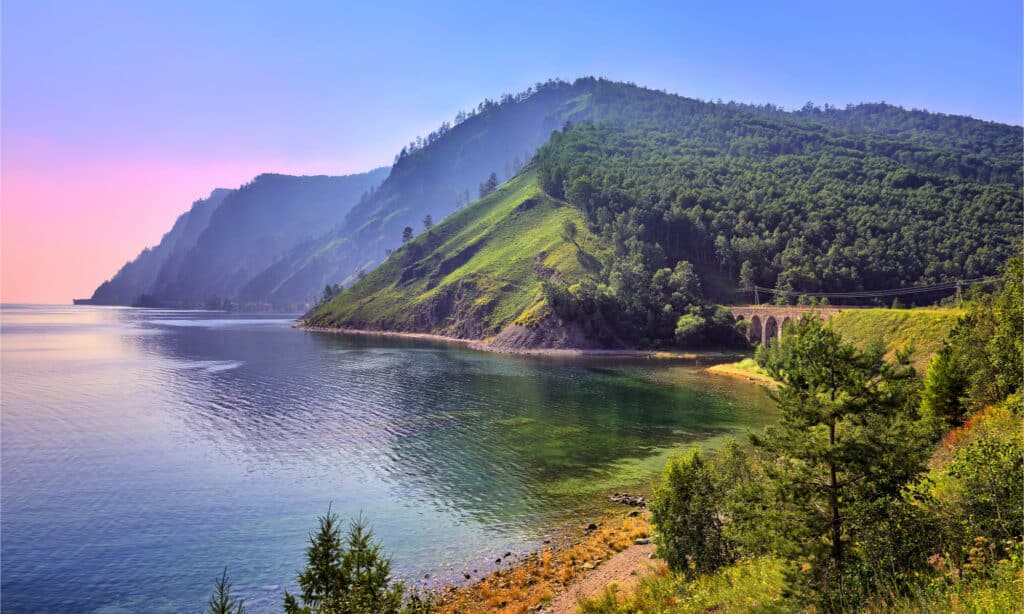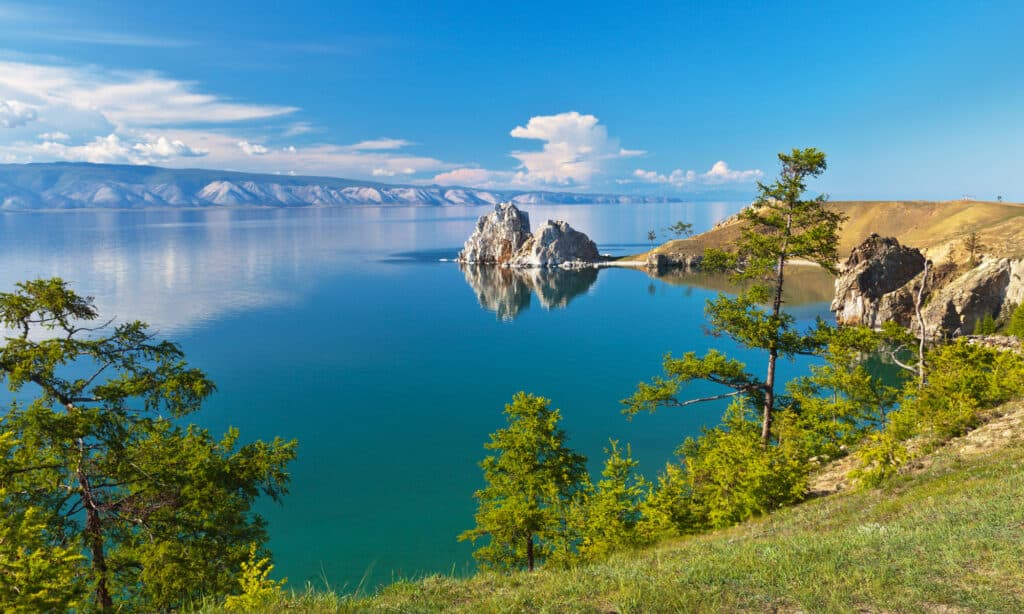Dubbed as “the Pearl of Siberia,” Lake Baikal isn’t only the deepest lake in the world but also one of the most beautiful. Surrounded by magnificent trees, this UNESCO World Heritage is famous for its vast freshwater and rich ecosystem. It even has its freshwater seal species that is endemic to the area. The lake is so beautiful that when Russian writer Chekhov first stepped on the shores of Lake Baikal, he described it as nothing he had ever seen. Located in southern Siberia in Russia, Lake Baikal is attractive to hundreds of thousands of visitors worldwide. But apart from its world-famous beauty and massive volume of water, what other incredible facts does Lake Baikal hold? The most amazing fact about Lake Baikal – depth! As the world’s deepest lake, how deep is Lake Baikal? This article will answer that and more.
How Deep is Lake Baikal?

With a maximum depth of 5387 feet, Lake Baikal is the deepest lake in the world.
©Julia Kuzenkova/Shutterstock.com
Lake Baikal holds the title of the deepest lake in the world, having a maximum depth of 5,387 feet or 1,642 meters. But apart from being the deepest, it is also the largest freshwater lake on the planet by water volume. The North American Great Lakes has 20% of the Earth’s surface freshwater, while Lake Baikal contains 22-23%, which means Lake Baikal contains more than the waters of all the five Great Lakes combined, comprising almost one-fifth of the world’s freshwater. Lake Baikal contains 23,615.39 cubic kilometers or 5,670 cubic miles and a wowing surface area of 31,722 square kilometers or 12,248 square miles.
Lake Baikal is situated near the Mongolian border in south-central Russia. It has always occupied a prominent place in Russian folklore and is frequently referred to as the Sacred Sea since it embodies Russia’s natural beauty. Though situated in the freezing region of Siberia, the shores surrounding Lake Baikal are warmer than the rest of the area because of the large mass of water. More than 300 rivers and streams feed Lake Baikal, but it only drains through the Angara River, eventually flowing down to the Arctic Ocean. The Selenga River in Mongolia is the largest water source of Lake Baikal, contributing about 50% of its water. Apart from all mentioned, Lake Baikal crosses many other items that make it remarkable. Below, we will explore the five best facts about Lake Baikal.
1. Lake Baikal is the oldest lake in the world.

Lake Baikal is at least 25 million years old.
©Nikitin Victor/Shutterstock.com
Apart from having the deepest maximum depth among all lakes in the world and harboring more than one-fifth of all the world’s freshwater, Lake Baikal also holds the crown for the oldest lake in the world. Lake Baikal is at least 25 million years old, formed by movements and fractures in the Earth’s crust. The magnificent mountains surrounding it were also formed along the lake due to the same movements. It was most likely once a riverbed. However, tremors and fissures in the Earth’s crust might have enlarged the distance between the shores and increased its size. Portions of the Baikal basin formed during the Tertiary Period, which happened approximately 66 million to 2.6 million years ago. Water levels were also raised as glaciers melted.
It’s believed that during the Pliocene Epoch, which was 5.3 to 2.58 million years ago, a series of lakes comparable to the Great Lakes formed first and later merged. Falling rocks, erosion, sinking of Earth, and earthquakes are some of the explanations that have been proposed to explain the unification. It was most likely a combination of all of them. Lake Baikal is located in a rift basin, which experiences about 2,000 seismic tremors every year. The tremors cause the lake to deepen and grow in size.
Given the lake’s wide surface area and an incredibly deep lowest point, Lake Baikal is an ocean waiting to be born. The shores in the lake also drift apart by approximately 0.78 inches or 2 cm every year, which is the same rate by which South America and Africa drift farther apart.
2. Lake Baikal has the clearest water in the world, with underwater visibility reaching 40 meters.
Considering Lake Baikal’s wowing depth, you may easily think that it is hard to look through the lake’s deep waters. You might not be able to see through its bottom, but you can see some extremely deep parts of the lake. Lake Baikal prides itself as one of the clearest and cleanest freshwater lakes in the world, with underwater visibility reaching 30 to 40 meters. This means that if you sail on a boat above its waters, you can see the lake’s magnificent ecosystem within! Because of the lake’s extremely clear water, it also creates a unique phenomenon during cold days. When its water freezes almost completely, it forms a stunning and uncommon crystal-clear ice sheet that can measure from 3 to 6 feet thick. If you aren’t boating over the lake’s water surface, this is a good opportunity to look into Lake Baikal’s waters and rich marine biodiversity. As the ice coming from the Siberian mountains melts in the summer, you can see up to 130 feet or 39 meters down.
The lake’s distinctly clear water is due to the purity of the melted ice from the surrounding mountains. Lake Baikal also hosts a healthy plankton population that consumes and cleans floating debris. Another reason for the lake’s clarity is its lack of salt minerals. On clearer days, stones at the bottom of the lake can easily be seen. Lake Baikal has a composition like that of distilled water, proving its high purity level.
3. Lake Baikal has 27 islands and is home to a rich and unique ecosystem.

Lake Baikal is home to 60 fish species and 2500 various animals.
©Katvic/Shutterstock.com
Like many other lakes, Lake Baikal has a collection of islands – encompassing 27 islands that provide a home to diverse animals. The most famous island is Olkhon Island, known as the pilgrimage site and home of the shamans. This UNESCO World Heritage site is home to 60 fish species endemic to the lake, 236 different bird species, 2,500 various animals, and 1,000 plant varieties. Lake Baikal even has its species of freshwater seal called the Baikal seal, which is quite remarkable as it is the only pinniped that exclusively settles in a freshwater habitat.
The lake indeed hosts not only rich biodiversity but also a unique ecosystem. Of approximately 3,700 species of animals and plants living in and around the lake, nearly 80% of them cannot be found anywhere else in the world, except in Lake Baikal. Because of its unique biodiversity and significance to evolutionary science, Lake Baikal is frequently referred to as the “Galapagos of Russia.” Lake Baikal has one of the world’s richest and largest freshwater ecosystems due to its antiquity, seclusion, and deep oxygenated water. While most of these animals are found at the bottom of the lake, tourists can still catch a glimpse of its eccentric Baikal seals, locally called “nerpa.” When it comes to the history of nerpas, scientists aren’t sure how the nerpa got to Lake Baikal or how it evolved, but they think the seals swam from the Arctic through a prehistoric river. The oily, scaleless golomyanka fish and the omul, one of Lake Baikal’s most famous delicacies, are two more species endemic to the lake.
Apart from fish, Lake Baikal also gives a home to land animals like reindeer, elk, wolves, bears, wild boars, and more. Various types of arthropods like insects, crustaceans, and mollusks can also be found in the lake.
4. Water in Lake Baikal is replenished every 383 years.
As the world’s largest lake by water volume, it is not surprising that the water in Lake Baikal can fill 9 billion Olympic swimming pools. Calculating that each person only drinks 500 liters of water every year, the Earth’s entire population can live through Lake Baikal’s waters alone for nearly 40 years. Lake Baikal is extremely slow-moving with this massive volume as it only has one river outlet. At its current rate, Lake Baikal replenishes its water completely every 383 years, almost twice the time it takes for Lake Superior, the biggest of all five North American Great Lakes, to drain its water system. The water in the upper layer of the lake renews more often and faster, while the deeper layers of water take decades before completely flowing out.
5. Lake Baikal is the only deep lake with oxygenated water at its deepest points.
Apart from its qualifying features to be called an ocean, Lake Baikal has another similarity to the oceans – it has oxygenated water at its lowest depths. Lake Baikal sports oxygenated water even at its deepest points, letting more marine animals settle at the lake’s bottom despite its incredible depth. The lake’s depths are also studied to be warm, but the cause of the heat is still unknown.
Observing the magnificent night sky in Lake Baikal is unlike anything else on the planet. Stargazing around Baikal is a genuinely unforgettable moment with no city lights to distract you.
Where is Lake Baikal Located on a Map?
Russia is home to this large lake. Lake Baikal is located in the southern part of east Siberia, nestled between the federal subjects of Irkutsk Oblast and the Republic of Buriyatia. It is north of the Mongolian border.
The photo featured at the top of this post is © Katvic/Shutterstock.com
Thank you for reading! Have some feedback for us? Contact the AZ Animals editorial team.






